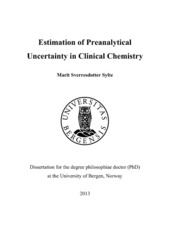Estimation of Preanalytical Uncertainty in Clinical Chemistry
Doctoral thesis
Permanent lenke
https://hdl.handle.net/1956/6709Utgivelsesdato
2013-05-27Metadata
Vis full innførselSamlinger
Sammendrag
Preanalytical uncertainty is attributable to variations in blood sample collection and sample handling before analysis. The aim of this study was to establish a modelling framework for estimating preanalytical uncertainty. There is a need for standardization on which uncertainty sources that should be included, and how the preanalytical uncertainty should be estimated. In Paper I, an uncertainty budget was established based on differences in paired data between a standard method for handling blood samples and alternative methods used in current practice, considering the distribution of alternative methods. In Paper II and III, linear mixed-effects models were used to estimate the between-venipuncture SD, the preanalytical SD (excluding the betweenvenipuncture SD), and the measurement repeatability when the phlebotomy and the sample handling were performed optimally, and any difference in preanalytical SD and fixed effects, between transporting blood samples in a pneumatic tube system vs manual delivery, using different needles or tubes, and mixing methods. When the combined biases from the uncertainty budget in Paper I and the significant biases between different treatments in Paper II and III were compared with defined quality specifications for analytical bias, glucose was the only analyte falling outside the quality specifications. Prolonged clotting and storage time were the greatest contributors to the bias for glucose, and the significant mean difference between SST vs RST tubes shows that choice of tube is important. The preanalytical SDs (excluding the between-venipuncture SD) for LD and potassium for optimally treated samples, were significantly higher than the measurement repeatability SDs, but for glucose, the between-venipuncture SD was the dominant source of variation. For most analytes, the preanalytical SDs were about the same in both studies II and III, indicating that the preanalytical variations are little influenced by different preanalytical handling. We have developed two models that can be used to estimate preanalytical uncertainty in clinical chemistry laboratories. Estimation of preanalytical uncertainty may improve diagnostic quality and patient treatment.
Består av
Paper I: Sylte, M. S., Wentzel-Larsen, T. & Bolann, B. J. (2007) A model for an uncertainty budget for preanalytical variables in clinical chemistry analyses. Clinical Chemistry 53(7): 1343-1348, July 2007. Full text not available in BORA due to publisher restrictions. The article is available at: http://dx.doi.org/10.1373/clinchem.2007.086371Paper II: Sylte, M. S., Wentzel-Larsen, T. & Bolann, B. J. (2010) Estimation of the minimal preanalytical uncertainty for 15 clinical chemistry analytes. Clinical Chemistry 56(8): 1329-1335, August 2010. Full text not available in BORA due to publisher restrictions. The article is available at: http://dx.doi.org/10.1373/clinchem.2010.146050
Paper III: Sylte, M. S., Wentzel-Larsen, T. & Bolann, B. J. (2013) Random variation and systematic error caused by various preanalytical variables, estimated by linear mixed-effects models. Clinica Chimica Acta 415: 196–201, January 2013. Full text not available in BORA due to publisher restrictions. The article is available at: http://dx.doi.org/10.1016/j.cca.2012.10.045
